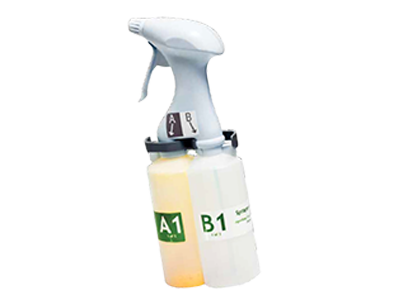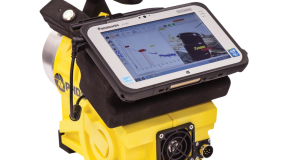Agentase C2 agent disclosure spray is the most sensitive detection technology available and complements electronic sensors by providing the ability to map chemical agent contamination for emergency response missions, as well as aid in the decontamination of personnel or equipment after exposure to CWAs, specifically nerve agents (G- & V-series) and sulphur mustard (HD). Agentase C2 can be used at many stages of the hazard management process to minimize spread of contamination, while near real-time detection allows for early deployment of counter measures and evacuation before human harm or loss of life can occur.
Agentase C2 incorporates enzymes, commonly used as catalysts to create very specific reactions. After being sprayed directly onto a surface, the Agentase C2 enzymes react by changing color to red within 5 minutes of detecting CWAs. This color change reveals the specific location of contamination, making the invisible threat…visible.
Agentase C2 is multi-purpose and easy to use, offered in three applicator sizes based on mission requirements: handheld, man-portable backpack, and wide-area cart-based systems. The Agentase C2 spray is compatible with a large variety of materials and does not degrade sensitive surfaces. It can be rinsed away with water and contains no hazardous chemicals requiring special disposal consideration. Furthermore, chemical agents are not chemically changed by Agentase C2. This allows for evidence collection and downstream forensic analysis of samples.
- Reliable – Ability to detect submicrogram (trace) levels of agents.
- Flexible – Offered in three applicator sizes based on mission requirements.
- Accurate – Reveals exact location of agent on surface to reduce decontamination costs.
- Fast – Rapid response (within 5 minutes).
- Simple – Training completed in less than 1 hour.
Military personnel and emergency responders use the Agentase C2 to visualise contamination hot spots and establish decontamination action plans. Decontamination efforts can be costly and stressful when the specific areas of contamination are hard to locate. Out of an abundance of caution, decontaminant is often applied even where it is not needed.
By using Agentase C2 to reveal specific contamination areas, users are able to focus their application to reduce the amount of decontaminant used and reduce the cost of decon up to 60%, while reducing post-decon verification from 10 hours to only 2 (for a sample size of ten HMMWV vehicles). Agentase C2 can also be used for post-decontamination assurance following a water rinse to verify the effectiveness of decontamination.
Agentase C2 also allows users to reliably identify the perimeter of a hot zone during emergency response missions. The 1995 Sarin attack on the Tokyo subway provides a specific example of how Agentase C2 can be utilized. Packets containing Sarin were punctured and left on subway trains, which slowly volatilised and made passengers sick. Passengers left the immediate hot-zone and carried the contamination with them to the hospital, creating mobile hot-zones. The attack resulted in 8 deaths and nearly 5,500 people were treated for nerve agent poisoning. Emergency responders and hospitals were unprepared for mitigating the spread of contamination. Agentase C2 can be used at many stages of the hazard management process to minimize spread of contamination, while near real-time detection allows for early deployment of counter measures and evacuation before human harm or loss of life can occur.
Documents
-
FLIR-Agentase-C2-Datasheet-EU-Version-1.0
Download (458.49 kB)



